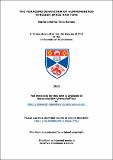The foraging behaviour of hummingbirds through space and time
Abstract
Central place foragers, such as territorial hummingbirds, feed from resources that tend to be constant in space and to replenish with time (e.g. nectar in flowers). The ability to remember both where and when resources are available would allow these animals to forage efficiently. Animals that feed at multiple locations would also benefit from forming routes between these multiple locations. Hummingbirds are thought to forage by repeating the order in which they visit several locations following a route called a “trapline”, although there are no quantitative data describing this behaviour. As a first step to determining how and if wild free living hummingbirds forage by traplining, I decomposed this behaviour into some of its key components. Through five field experiments, where I trained free-living hummingbirds to feed from artificial flowers, I confirmed that territorial hummingbirds will, in fact, trapline. Birds will use the shortest routes to visit several locations and will prioritize those locations that are closest to a usual feeding site. Additionally, even though hummingbirds can learn to use temporal information when visiting several patches of flowers, the spatial location of those patches has a larger influence in how these birds forage in the wild. Since male and female hummingbirds were thought to forage differently I also tested whether there were sex differences in the types of cues they use when foraging. Contrary to expectation, female hummingbirds will also use spatial cues to relocate a rewarded site. Using the foraging ecology of rufous hummingbirds to formulate predictions as to what information these birds should use has lead me to discover that these birds forage in a completely different way than previously thought.
Type
Thesis, PhD Doctor of Philosophy
Rights
Creative Commons Attribution-NonCommercial-NoDerivatives 4.0 International
http://creativecommons.org/licenses/by-nc-nd/4.0/
Collections
Description of related resources
The work described in Chapter 3 forms the basis of “Tello-Ramos, Maria C., Hurly, T Andrew & Healy, Susan D. 2015. Traplining in hummingbirds: flying short-distance sequences among several locations. Behavioral Ecology. 26: 812-819”.The work described in Chapter 4 forms the basis for the paper “Tello-Ramos Maria C., Hurly, T Andrew, Higgott, Caitlin & Healy, Susan D. 2015. Time-place learning in wild, free-living hummingbirds. Animal Behaviour. 104:123-129”.
The work presented in Chapter 6 forms part of “Tello-Ramos, Maria. C., Hurly, T. Andrew & Healy, Susan D. 2014. Female hummingbirds do not relocate rewards using colour cues. Animal Behaviour.93: 129-133”.
Except where otherwise noted within the work, this item's licence for re-use is described as Creative Commons Attribution-NonCommercial-NoDerivatives 4.0 International
Items in the St Andrews Research Repository are protected by copyright, with all rights reserved, unless otherwise indicated.


